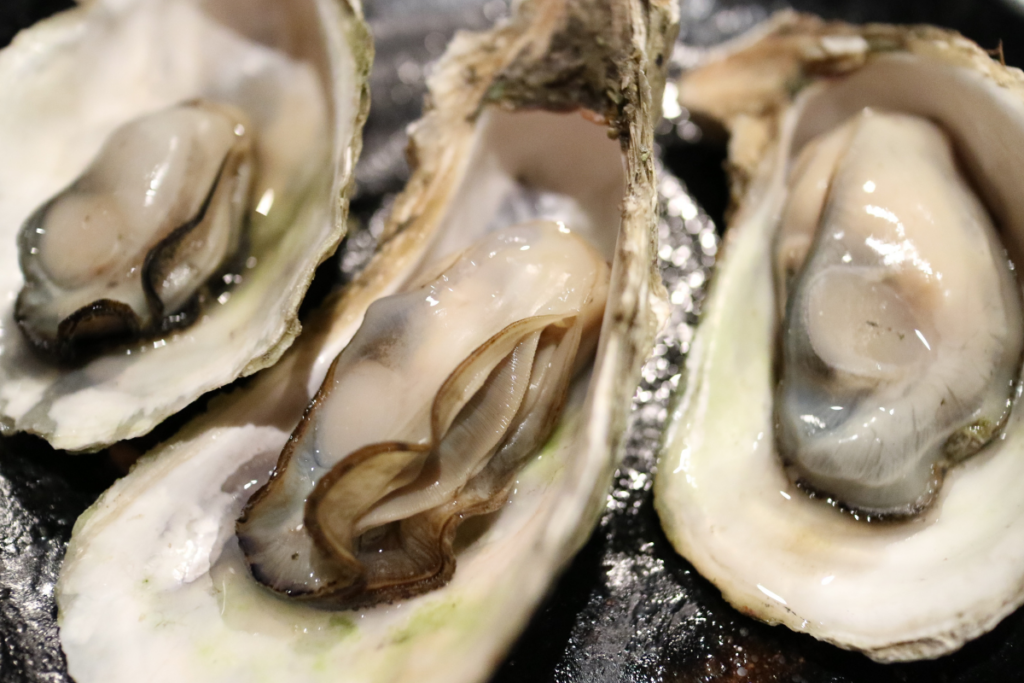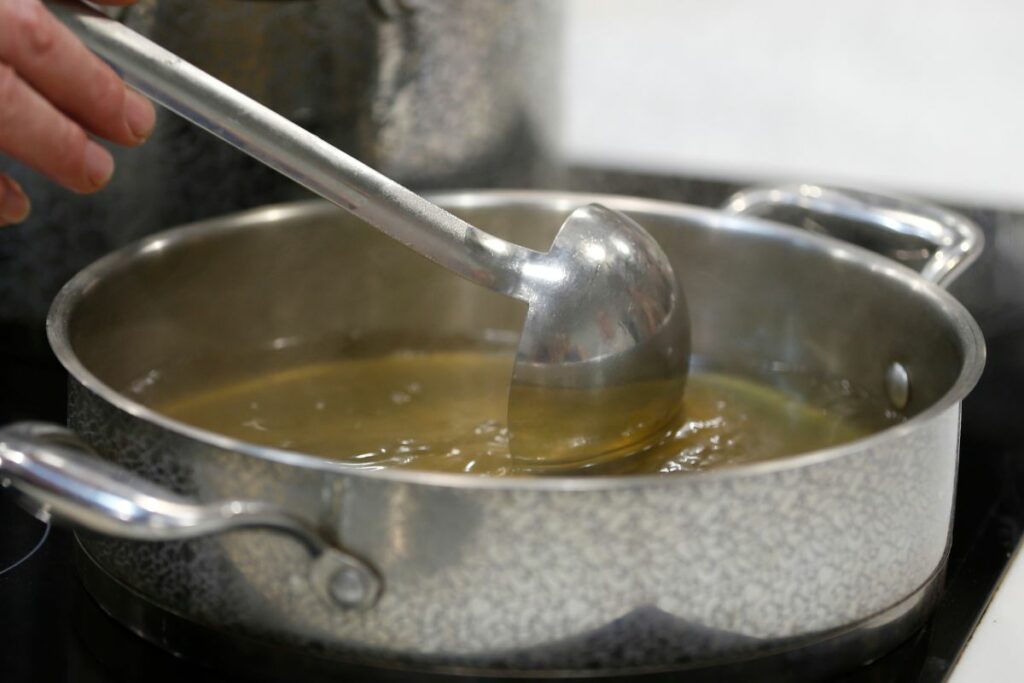Seafood stock is a flavorful base for many seafood dishes, soups, and sauces. However, it may not always be readily available or suitable for certain dietary restrictions. In such cases, seafood stock substitutes can be used to achieve a similar taste and flavor profile.
There are several seafood stock substitutes that can be used in place of traditional seafood stock. One option is fumet, which is made by simmering the heads and bones of non-fatty fish like white fish or halibut. It can add a savory taste and flavor to seafood recipes, soups, and sauces. Another substitute is clam juice, which can be used in a variety of dishes and can also be used as a flavorful poaching liquid for seafood like fish or shrimp. Vegetable stock can also be used as a substitute, as it is made from carrots, celery, and onions and has a light and mild taste.

Contents
- 1 Understanding Seafood Stock
- 2 Why Substitute Seafood Stock?
- 3 Common Seafood Stock Substitutes
- 4 Homemade Seafood Stock Substitutes
- 5 Substitutes for Specific Dishes
- 6 Fish Stock Substitutes
- 7 Vegan Seafood Stock Substitutes
- 8 Buying Seafood Stock Substitutes
- 9 Understanding Umami Flavor
- 10 Substitute Instructions
- 11 Nutritional Aspects of Substitutes
- 12 Differences Between Substitutes
Understanding Seafood Stock
Seafood stock is a flavorful liquid made by simmering seafood, such as fish, shrimp, or lobster, with vegetables, herbs, and spices. The resulting stock is used as a base for soups, stews, sauces, and other dishes that require a rich seafood flavor.
The process of making seafood stock involves simmering the bones, heads, and shells of the seafood in water, along with aromatic vegetables like onions, celery, and carrots. The stock is then strained to remove any solids, leaving a clear and flavorful liquid.
Seafood stock is a versatile ingredient that can be used in a variety of dishes, from classic French bouillabaisse to Italian cioppino to Asian-style hot pot. It adds depth and complexity to any seafood dish, enhancing the natural flavors of the seafood and creating a rich and savory broth.
While seafood stock is a delicious and essential ingredient in many recipes, it can be difficult to find in stores. Fortunately, there are several substitutes that can be used in place of seafood stock. Some of the best substitutes include vegetable stock, chicken stock, clam juice, and fish fumet. Each of these substitutes has its own unique flavor profile and can be used to add depth and complexity to seafood dishes.
In summary, seafood stock is a flavorful liquid made by simmering seafood, vegetables, and spices. It is a versatile ingredient that can be used in a variety of dishes and adds depth and complexity to seafood dishes. If you don’t have seafood stock on hand, there are several substitutes that can be used to achieve similar results.
Why Substitute Seafood Stock?
Seafood stock is a flavorful and essential ingredient in many seafood dishes, soups, and sauces. However, sometimes it may not be available or may not be suitable for certain dietary restrictions or preferences. In such cases, it is useful to have knowledge of seafood stock substitutes.
There are several reasons why someone may need to substitute seafood stock. For example, they may be allergic to shellfish or fish, or they may be vegetarian or vegan. Moreover, some people may not like the taste or smell of seafood stock.
Fortunately, there are several alternatives to seafood stock that can be used in recipes without compromising the flavor or texture of the dish. Some of the most common substitutes for seafood stock are vegetable stock, chicken stock, and clam juice. Additionally, some recipes may call for water or white wine as a substitute for seafood stock.

It is important to note that different substitutes may work better in different recipes. For example, vegetable stock may be a suitable substitute for seafood stock in vegetarian or vegan recipes, while chicken stock may be a better option for non-vegetarian recipes. Similarly, clam juice may work well in recipes that require a briny flavor, while water or white wine may be better suited for recipes that require a milder flavor.
In summary, there are several reasons why someone may need to substitute seafood stock, and there are several alternatives to choose from. The choice of substitute will depend on the recipe and the individual’s dietary restrictions and preferences.
Common Seafood Stock Substitutes
Seafood stock is a flavorful base for many seafood dishes, soups, and sauces. However, not everyone has access to seafood stock or may prefer not to use it. Fortunately, there are several substitutes that can be used in place of seafood stock without compromising the flavor of the dish.
Here are some common seafood stock substitutes:
Fish Stock
Fish stock, also known as fumet, is the most obvious substitute for seafood stock. It is made by simmering the heads and bones of non-fatty fish, such as white fish or halibut. Fumet can add a savory taste and flavor to seafood recipes and is widely used in seafood dishes, soups, and sauces.
Clam Juice
Clam juice is another excellent substitute for seafood stock. It can be used in a variety of dishes, such as soups, stews, risottos, and sauces. Clam juice can also be used to make a flavorful poaching liquid for seafood, such as fish or shrimp. To use clam juice instead of seafood stock, simply replace the seafood stock with an equal amount of clam juice.
Chicken Stock
Chicken stock can be used as a substitute for seafood stock in non-seafood dishes. It has a mild flavor that won’t overpower the other ingredients in the dish. However, it won’t provide the same seafood flavor as seafood stock.

Beef Stock
Beef stock can also be used as a substitute for seafood stock in non-seafood dishes. It has a rich, hearty flavor that can add depth to the dish. However, like chicken stock, it won’t provide the same seafood flavor as seafood stock.
Vegetable Stock
Vegetable stock is a good substitute for seafood stock in vegetarian or vegan dishes. It has a light, clean flavor that won’t overpower the other ingredients in the dish. However, it won’t provide the same seafood flavor as seafood stock.
Dashi
Dashi is a Japanese stock made from simmering dried kelp and bonito flakes. It has a subtle umami flavor that can add depth to seafood dishes. Dashi can be used as a substitute for seafood stock in Japanese dishes, such as miso soup and udon noodle soup.
Miso Soup
Miso soup is a Japanese soup made from dashi and miso paste. It has a savory, salty flavor that can add depth to seafood dishes. Miso soup can be used as a substitute for seafood stock in Japanese dishes, such as ramen and soba noodle soup.
Water
In a pinch, water can be used as a substitute for seafood stock. However, it won’t provide the same flavor as seafood stock or any of the other substitutes listed above. To add flavor to the dish, consider adding herbs, spices, or other seasonings.
Overall, there are several substitutes for seafood stock that can be used in a variety of dishes. Each substitute has its own unique flavor profile and works best in certain types of dishes. By experimenting with different substitutes, you can find the perfect substitute for your dish.

Homemade Seafood Stock Substitutes
If you don’t have seafood stock on hand, you can easily make a substitute at home with a few simple ingredients. Here are some homemade seafood stock substitutes that you can try:
Vegetable Stock
One of the easiest substitutes for seafood stock is vegetable stock. To make vegetable stock, simply simmer onions, carrots, and garlic in water with bay leaves and fresh parsley. This flavorful stock can be used in place of seafood stock in soups, stews, and sauces.
Clam Juice
If you have clam juice on hand, you can use it as a substitute for seafood stock. Clam juice has a slightly briny flavor that works well in seafood dishes. You can use clam juice in the same amount as seafood stock in recipes.
Fumet
Fumet is a concentrated fish stock that is commonly used in French cuisine. To make fumet, simmer fish bones, non-fatty sea fish heads, vegetables or seaweed, and lobster shells in water. This flavorful stock can be used in place of seafood stock in bouillabaisse and other seafood dishes.
Shrimp Stock
If you have shrimp shells on hand, you can make a flavorful shrimp stock. Simply simmer the shrimp shells in water with onions, carrots, and garlic. This stock can be used in place of seafood stock in recipes.
Fish Sauce
Fish sauce is a salty, savory liquid made from fermented fish. While it may not be a perfect substitute for seafood stock, it can add a similar umami flavor to dishes. Use fish sauce sparingly, as it can be quite strong.
These homemade seafood stock substitutes are easy to make and can add a delicious flavor to your recipes. Try them out the next time you’re in a pinch and don’t have seafood stock on hand.

Substitutes for Specific Dishes
When it comes to substituting seafood stock in specific dishes, there are various options available. Here are some substitutes that can be used in different types of dishes:
Soups and Sauces
For soups and sauces, vegetable broth or chicken broth can be used as a substitute for seafood stock. Both of these options have a similar consistency and flavor profile and can provide a savory taste to the dish. In addition, clam juice can also be used as a substitute for seafood stock in soups and sauces.
Paella
Paella is a Spanish dish that is traditionally made with seafood stock. However, if you don’t have seafood stock, you can use chicken broth or vegetable broth instead. These substitutes will not only provide a similar flavor profile but also give the dish a unique taste.
Bouillabaisse
Bouillabaisse is a French fish soup that is typically made with seafood stock. If you don’t have seafood stock, you can use fish stock or vegetable broth instead. These substitutes will add a similar depth of flavor to the soup and ensure that the dish remains flavorful.
Chowder
Chowder is a creamy soup that is traditionally made with seafood stock. If you don’t have seafood stock, you can use chicken broth or vegetable broth instead. These substitutes will provide a similar consistency and flavor profile to the soup and make it a hearty and satisfying meal.
Lobster Bisque
Lobster bisque is a rich and creamy soup that is made with seafood stock. If you don’t have seafood stock, you can use chicken broth or vegetable broth instead. These substitutes will provide the soup with a similar consistency and flavor profile and make it a delicious and comforting meal.

Seafood Dishes
For seafood dishes, clam juice or fish stock can be used as a substitute for seafood stock. These substitutes will provide a similar flavor profile and ensure that the dish remains flavorful and delicious. In addition, vegetable broth or chicken broth can also be used as a substitute for seafood stock in seafood dishes.
Fish Stock Substitutes
When it comes to cooking seafood dishes, fish stock is a common ingredient used to enhance the flavor. However, not everyone has fish stock readily available in their pantry. Luckily, there are a variety of fish stock substitutes that can be used to achieve a similar taste.
One of the best substitutes for fish stock is fumet. Fumet is a French term for fish stock that is made by simmering fish bones and heads with vegetables and herbs. It has a rich and savory flavor that can add depth to seafood dishes, soups, and sauces. Fumet can be made using non-fatty white fish such as halibut or cod.
Another substitute for fish stock is clam juice or other types of seafood stock. These substitutes have the essence of the ocean and can be used in a variety of dishes. Clam juice can be used to make flavorful poaching liquid for seafood like fish or shrimp.
If you don’t have any seafood stock available, you can use chicken broth or vegetable stock as a substitute. While it won’t have the same fish flavor, it can still add depth to your dish.
Dashi is a Japanese stock made from dried bonito flakes and kombu seaweed. It has a smoky and savory flavor that can be used as a substitute for fish stock.
In a pinch, you can also use fish sauce or Worcestershire sauce diluted with water. These sauces have a strong flavor that can add a fishy taste to your dish.
Overall, there are many fish stock substitutes available that can be used to achieve a similar flavor. Whether you use fumet, clam juice, or vegetable stock, experimenting with different substitutes can help you find the perfect flavor for your dish.
Vegan Seafood Stock Substitutes
For those who prefer a plant-based diet or have dietary restrictions, there are several vegan substitutes for seafood stock that can be used in recipes. Here are some options to consider:

- Mushroom Stock: Mushroom stock can be a great substitute for seafood stock, as it has a savory umami flavor that is similar to seafood. To make mushroom stock, simply simmer mushrooms, onion, garlic, and herbs in water for several hours. Strain the liquid and use it in place of seafood stock in recipes.
- Vegetable Broth: Vegetable broth is another option for those who want a vegan substitute for seafood stock. It can be made by simmering vegetables, herbs, and spices in water for several hours. Use vegetable broth in place of seafood stock in recipes.
- Vegan Version: There are also vegan versions of seafood stock available in some specialty stores or online. These substitutes are often made with seaweed or other plant-based ingredients to mimic the flavor of seafood. Check the ingredient list to ensure that the product is vegan and suitable for your dietary needs.
When using a vegan substitute for seafood stock, keep in mind that the flavor may be slightly different than traditional seafood stock. Experiment with different substitutes to find the one that works best for your recipe and personal taste preferences.
Buying Seafood Stock Substitutes
When it comes to buying seafood stock substitutes, there are several options available in the market. A grocery store or a market near you is likely to have a variety of substitutes to choose from. Some of the most common substitutes include bottled clam juice, concentrated stock, powder, bouillon cubes, and dashi powder.
Bottled clam juice is a popular substitute for seafood stock. It is readily available in most grocery stores and can be used in a variety of dishes. It has a salty and savory taste that makes it an excellent ingredient for soups, stews, and sauces. It is also a great alternative for poaching seafood like fish or shrimp.
Concentrated stock is another option for those looking for seafood stock substitutes. It comes in a small jar or tube and can be diluted with water to make a flavorful stock. This option is convenient and easy to use, but it can be pricier than other substitutes.
Powdered substitutes are also available in the market. They are usually sold in packets or jars and are easy to store. They can be added to water to make a quick and easy seafood stock substitute. However, it is important to check the ingredients and nutritional information before purchasing, as some brands may contain high levels of sodium or other additives.
Bouillon cubes are another popular option for those looking for seafood stock substitutes. They are easy to use and can be dissolved in water to make a quick and flavorful stock. However, like powdered substitutes, it is important to check the ingredients and nutritional information before purchasing.

Dashi powder is a Japanese seasoning made from dried fish and seaweed. It is a great substitute for seafood stock in Japanese dishes like miso soup and ramen. It has a unique umami flavor that can enhance the taste of seafood dishes.
Overall, when buying seafood stock substitutes, it is important to consider the flavor, convenience, and nutritional value of the product. It is also important to read the label and check for any allergens or additives. With so many options available, it is easy to find a substitute that fits your needs and preferences.
Understanding Umami Flavor
Umami is one of the five basic tastes, alongside sweet, sour, bitter, and salty. It is often described as a savory or meaty taste and is commonly found in foods like meat, cheese, and mushrooms.
The umami flavor is caused by the presence of glutamates, which are amino acids that naturally occur in many foods. When glutamates are present in food, they stimulate specific taste receptors on the tongue, resulting in the umami taste.
Seafood is also known for its umami flavor, which is why seafood stock is a popular ingredient in many recipes. Clam juice, for example, is a liquid derived from clams and is often used in recipes to provide a briny, umami-rich flavor.
In addition to providing flavor, glutamates also have a natural flavor-enhancing quality. This is why adding a small amount of seafood stock or clam juice to a recipe can help to enhance the overall taste of the dish.
Overall, understanding the umami flavor and the role of glutamates in creating it can help you to choose the right ingredients and enhance the flavor of your dishes.
Substitute Instructions
Substituting seafood stock in a recipe can be a bit tricky, but it is possible to achieve similar results with a few adjustments. Here are some substitute instructions to help you out:
1. Simmering
When substituting seafood stock with another liquid, it is essential to simmer the liquid to release its flavors fully. This process will help to enhance the taste of the dish and give it a seafood-like flavor. To achieve this, simply add the substitute liquid to the recipe and let it simmer for at least 15 minutes.

2. Diluted Fish Sauce
Fish sauce is a popular ingredient in many Asian dishes and can be used as a substitute for seafood stock. To use fish sauce as a substitute, dilute it with water in a 1:1 ratio. For example, if a recipe calls for one cup of seafood stock, use half a cup of fish sauce and half a cup of water. The diluted fish sauce will add a savory and salty flavor to the dish.
3. Diluted Worcestershire Sauce
Worcestershire sauce is a complex blend of flavors that can add depth to a dish. To use it as a substitute for seafood stock, dilute it with water in a 1:1 ratio. For example, if a recipe calls for one cup of seafood stock, use half a cup of Worcestershire sauce and half a cup of water. The diluted Worcestershire sauce will add a tangy and savory flavor to the dish.
4. Other Substitutes
Other substitutes for seafood stock include vegetable stock, fumet, clam juice, and miso soup. Each of these options has a unique flavor profile, so it’s best to choose the one that complements the dish you are making. Vegetable stock is a light and mild alternative that works well in dishes where seafood is not the star ingredient. Fumet, which is a concentrated fish stock, is a great substitute for seafood stock in bouillabaisse or other seafood stews. Clam juice can be used in a variety of seafood dishes, such as soups, stews, risottos, and sauces. Miso soup is a Japanese broth made from fermented soybeans and has a rich umami flavor that can enhance the taste of a dish.
By following these substitute instructions, you can create delicious seafood dishes even when you don’t have seafood stock on hand.
Nutritional Aspects of Substitutes
When it comes to cooking, using substitutes for seafood stock can be an excellent option for those who are looking for healthier alternatives. Many substitutes are low in calories and high in nutrients, making them a great choice for those who want to maintain a healthy diet. Here are some of the nutritional aspects of substitutes for seafood stock:

Nutrients
Substitutes for seafood stock are often rich in nutrients, such as protein, vitamins, and minerals. For example, vegetable broth, which is a popular substitute for seafood stock, is high in vitamin C, vitamin K, and folate. Chicken broth, another popular substitute, is a good source of protein, niacin, and selenium. Clam juice, which can also be used as a substitute, is high in vitamin B12, iron, and potassium.
Minerals
Substitutes for seafood stock can also be a good source of minerals, such as calcium. For example, dashi, a Japanese broth made from kombu (a type of seaweed) and bonito flakes (dried fish flakes), is high in calcium, magnesium, and iodine. Fumet, which is made from fish bones, is also a good source of minerals like calcium and phosphorus.
Calcium
Calcium is an essential mineral that is important for bone health. While seafood stock is not particularly high in calcium, some substitutes can be a good source of this mineral. For example, clam juice is high in calcium, with one cup providing about 120 mg of calcium. Dashi is also a good source of calcium, with one cup providing about 60 mg of calcium.
Overall, substitutes for seafood stock can be a healthy and nutritious option for those who want to maintain a healthy diet. They are often low in calories and high in nutrients, making them a great choice for those who want to add flavor to their dishes without adding extra calories.
Differences Between Substitutes
Seafood stock is a flavorful liquid that is made by simmering fish bones, shells, and heads in water. It is commonly used in soups, stews, sauces, and other seafood dishes to add a rich and savory flavor. However, if you don’t have seafood stock on hand or if you’re looking for a vegetarian or vegan alternative, there are several substitutes available. Here are some differences between seafood stock substitutes:
Flavor
One of the most important differences between seafood stock substitutes is the flavor. While seafood stock has a distinct taste that comes from the fish bones, shells, and heads, substitutes have different flavor profiles. For example, vegetable stock is made by simmering vegetables, herbs, and spices in water, and has a mild and slightly sweet flavor. Clam juice, on the other hand, has a briny and salty taste that is similar to seafood stock. Fumet, which is a type of fish stock, has a more intense fish flavor than seafood stock.

Texture
Another difference between seafood stock substitutes is the texture. Seafood stock has a rich and velvety texture that comes from the collagen and gelatin in the fish bones, shells, and heads. Some substitutes, such as vegetable stock, have a thinner and lighter texture. Others, such as clam juice and fumet, have a slightly thicker texture that is similar to seafood stock.
Similarities
Despite the differences in flavor and texture, seafood stock substitutes share some similarities. For example, they can all be used as a base for soups, stews, and sauces, and can add depth and complexity to seafood dishes. They can also be used interchangeably in many recipes, depending on your taste preferences and availability of ingredients.
In conclusion, there are several seafood stock substitutes available, each with its own unique flavor and texture. Whether you choose vegetable stock, clam juice, fumet, or another substitute, you can still enjoy the rich and savory taste of seafood dishes without using seafood stock.
